Commercial NAS Operating Systems - A Comprehensive Overview of Core Features
by Ganesh T S on November 14, 2016 8:30 AM ESTNetworking Features
Network-Attached Storage units connect to the network via one or more network interfaces. High-performance units come with at least two wired Gigabit LAN ports. Some units also support Wi-Fi dongles. Multiple network interfaces in a single system can be used for a variety of purposes - ranging from link aggregation to configuration of the NAS as a switch, and, in certain cases, dedicated network interfaces for virtual machines running on the NAS itself. In this section, we will take a look at the networking features offered by various COTS NAS operating systems.
The vendors are covered here in alphabetical order. Readers interested in jumping ahead to their vendor of interest can use the links below:
Asustor
Asustor's network settings are under 'Settings' > 'Network'. There are four different aspects handled in that section - the server name and gateway settings, as well as link aggregation (creation handled by a step-by-step wizard approach) are in the General tab.
The link aggregation settings can be set to any desired mode depending on the type of switch the NAS is connected to, as well as desired performance / operation.
The LAN section specifies whether the unit is set up with a static IP or, it acts as a DHCP client. The MTU can also be altered, and the current state of the interface is also visible. Advanced settings include 802.1Q VLAN tagging, with the option to set the VLAN ID. A proxy server can also be configured for use by the NAS. Asustor's ADM supports Wi-Fi dongles connected to the USB ports of their NAS units.
Netgear
Netgear puts all the network-related settings in the 'Network' option in the top-level menu. There are two sub-options - links and routes. The links refer to the physical interfaces. Clicking on the gear icon adjoining the interface names brings up various options, including the ability to make it bond with another one.
Various teaming modes are available, and the end user can choose one depending on the switch and desired performance.
ReadyNAS also allows the network interfaces to be part of a VLAN (802.1Q support with a specific VLAN ID). It is possible to alter the MTU value in the settings for each interface. DHCP client / static IP settings are also available. New routes can be added to a specific adapter, as shown in the above gallery.
QNAP
QNAP's networking configuration sections are under 'Control Panel' > 'System Settings'. The first section is the 'Network & Virtual Switch'. The Overview sub-section shows the various physical adapters in the system along with their IP addresses and real-time transfer rates in one view. The MAC addresses are also visible in a section to right.
The Interfaces sub-section allows setting of DNS servers and port trunking configuration. In models that support usage as a direct-attached storage unit (like the TS-451A in our testbed), the Interfaces section also has a 'USB QuickAccess' entry. The way the scheme works is to have a USB network adapter chip inside the NAS. When the USB cable is connected to a PC, the PC recognizes a new LAN adapter, and the contents of the NAS are visible over that interface. Since the connection is still over a LAN as far as either OS is concerned, various access restrictions that can be places on a network share can also be placed in the USB direct-attach mode. All of these aspects are brought out in the gallery below.
The IP address supplied to the USB LAN adapter can also be configured in the same section. Upon attachment to a PC, Qfinder Pro automatically delivers a 'USB QuickAccess detected' message. Even if Qfinder Pro were to be unavailable, users can just open up the network locations and access the 192.168.0.x subnet to view the QNAP NAS and access its contents in a 'direct-attach' mode.
Yet another interesting aspect is that of the Virtual Switch. QTS can configure a set of available adaters in either 'private network mode' or 'switch mode'. In the former, the NAS can act as a DHCP server on the selected interface. In the switch mode, the unit can act as a DHCP relay with the uplink port going to the router, and the downlink ports all connected to different devices that still act as DHCP clients for the main router in the system.
QTS also has a 'Network Access' section that helps in service binding - i.e, allowing some services only on certain interfaces. The configuration matrix can be seen in the above gallery. The NAS units can also be configured with a proxy, and options are available for using a dynamic DNS service. VPN client services are available through a separate VPN Client application available under 'Control Panel' > 'Applications'. Both PPTP and OpenVPN are supported.
Synology
Synology's network configuration options are available under 'Control Panel' > 'Connectivity' > 'Network'. Various link aggregation modes are supported when bonds are created in the Network Interface subsection.
The General configuration section helps set the server name as well as the adapter to use for the default gateway. A proxy server can also be configured. Under the Network Interface section, VPN connections (PPTP or OpenVPN or L2TP/IPSec) can also be created.>/p>
Synology's DSM also supports Open vSwitch for running Docker DSM and Virtual DSM. Traffic control rules in terms of guaranteed bandwith and limitation of bandwidth are available on a port-by-port basis. IP routing tables can also be set up. Wi-Fi options are available under 'Connectivity' > 'Wireless', with the NAS capable of acting as a wireless AP, a wireless router or just a WLAN client.
One of the interesting options buried in the DHCP Server section is the ability to turn on PXE (pre-boot execution environment). The boot loader needs to be placed in the root folder of a local or remote TFTP server in the same subnet as the DHCP client.
Western Digital
Western Digital's networking options under the 'Settings' menu has already been seen in multiple sections before. In this section, we just confirm that the My Cloud OS is able to support various teaming modes for link aggregation.
Other network options include static / DHCP IP configurations an jumbo frame / MTU settings. Port forwarding settings can also be configured automatically with a uPnP router. Certain options for standard service ports are readily available, as shown in the gallery above.
ZyXEL
ZyXEL doesn't carry any x86-based NAS units. Since most ARM-based NAS units are too weak to support high-performance teaming modes, ZyXEL opts for only load balancing and fault tolerance while creating a trunk. This setting can be reached via 'Control Panel' > 'Network' > 'TCP/IP' > 'Network Interface'.
The other available network settings are the bare minimum we expect from a NAS - DHCP or static IP choices for each interface, uPnP port mapping, and support for dynamic DNS service providers.


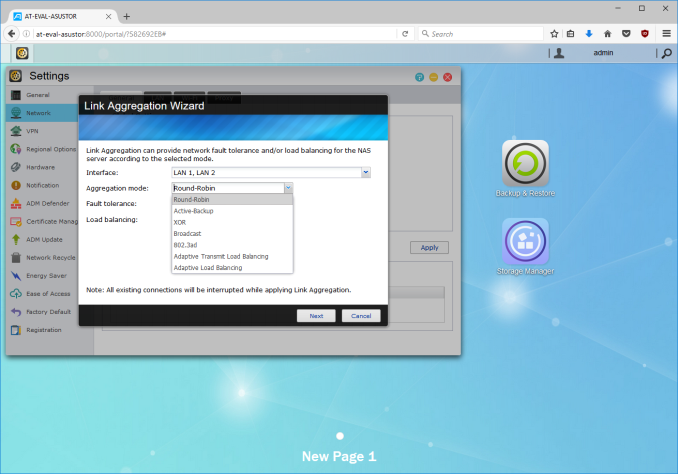






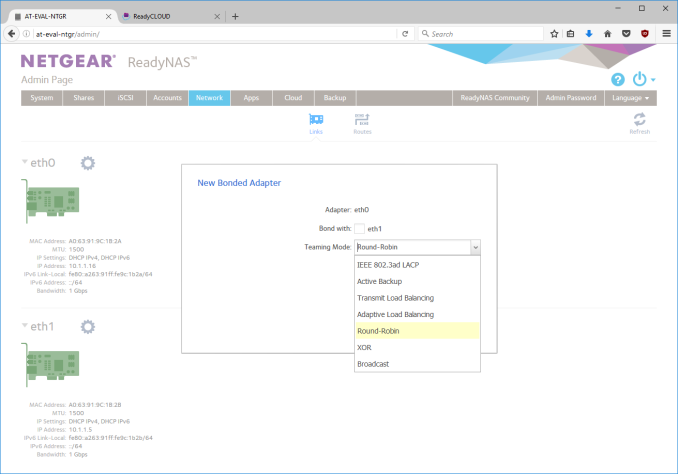






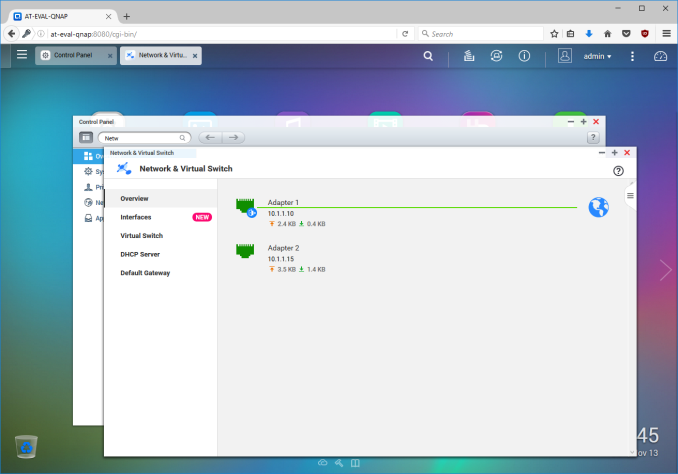






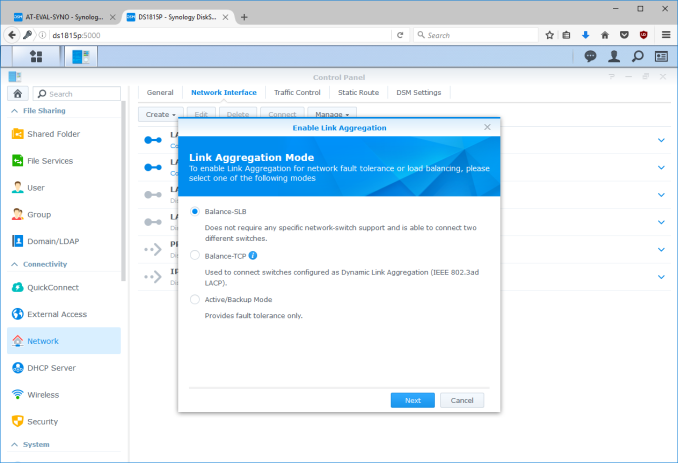













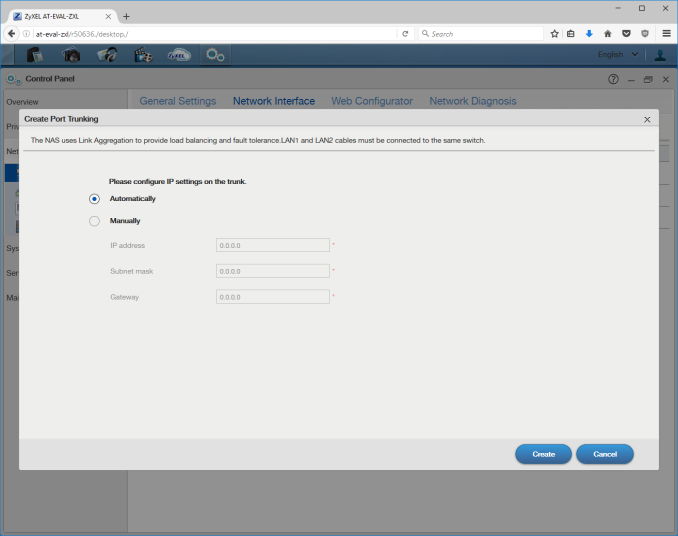














103 Comments
View All Comments
cdillon - Monday, November 14, 2016 - link
I meant to say "data and metadata check for ZFS" above, because it does both by default. You can turn off data checksums in ZFS just as easily as you can change the checksum algorithm, but can never turn off metadata checksums. ZFS will also never store less than 2 copies of all metadata (optionally more), giving you built-in redundancy in that respect, even in single-disk setups. This is one of several reasons that ZFS doesn't have and doesn't need a "fsck" utility, because the filesystem integrity is baked in to the design.tuxRoller - Thursday, November 17, 2016 - link
Btrfs has actually supported sha256...TWICE. The first time was back during early btrfs development and then they removed it because of how slow it was. It was submitted in 2014 by a oracle dev but not merged because they want a general solution, and, potentially, much more flexibility (using the crypto API instead of having to maintain their implementations;per file hash algorithm (so, some files could use a stronger hash than others); different hash functions for data and metadata (metadata is limited to 256 while data doesn't really have a limit))It's been percolating its way towards the kernel but it's not seen as a huge priority because: 1) there've been very few incidences of corrupt blocks passing ("crc32's error rate works out to one false positive per dozen megabytes *of random errors*--- that's a lot of errors, even talking into consideration CERN's data), 2) they already use sha256 for dedup (both in and out of band, though groundwork has been laid to make that pluggable as well).
linux-btrfs@vger.kernel.org/msg39109.html" target="_blank" rel="nofollow">https://www.mail-archive.com/linux-btrfs@vger.kern...
linux-btrfs@vger.kernel.org/msg39162.html" target="_blank" rel="nofollow">https://www.mail-archive.com/linux-btrfs@vger.kern...
linux-btrfs@vger.kernel.org/msg39205.html" target="_blank" rel="nofollow">https://www.mail-archive.com/linux-btrfs@vger.kern...
linux-btrfs@vger.kernel.org/msg50364.html" target="_blank" rel="nofollow">https://www.mail-archive.com/linux-btrfs@vger.kern...
ghostbit - Monday, November 14, 2016 - link
Nah. I am very happy with the Web interface and iOS apps Synology offers along with a sleek and small low-power chassis.But I guess I should also be ashamed I am not running a desktop with pfSense as a router as well?
dave_the_nerd - Monday, November 14, 2016 - link
Aside from the pfsense / FreeNAS issue - if you're using old desktop hardware as a server, yes, you should be ashamed. :-PIf you are using a prebuilt distro like FreeNAS instead of rolling your own distro, you should also be ashamed. Or something.
MrCrispy - Monday, November 14, 2016 - link
ZFS is expensive and hard. Can't mix and match drives, RAM hog, to expand a vdev you need to upgrade all disks, needs ECC ram, keeps all disks spinning, will slow down as you near capacity.The ZFS hype needs to stop. Its not at all suitable for a home user NAS, its meant for data centers.
bsd228 - Tuesday, November 15, 2016 - link
some of us don't see a difference, Crispy. I value my data as much as my datacenters' data.doggface - Tuesday, November 15, 2016 - link
Pfft. RAID is dead. Any decent array these days, is likely to get data corruption from hw raid.ZFS is rock solid. Also, if for some reason your OS/COTS solution dies your data is at significant risk of death. ZFS datasets are kept locally and you can rebuild the dataset regardless of the hardware.
eldakka - Wednesday, November 16, 2016 - link
RAID is dead? Huh?Sure, you can use ZFS without RAID, but that doesn't give you any hardware failure data protection.
I've rarely seen someone not use ZFS in some sort of RAID arrangement:
ZFS RAIDZ = RAID5
ZFS RAIDZ2 = RAID6
Software RAID (ZFS RAIDZ, RAIDZ2 and others) is still RAID.
doggface - Wednesday, November 16, 2016 - link
Ok. You got me, yes, it is uses an array of disks. Let me be more specific, RAID5 is a risk not worth taking. The reason they call it RAIDZ and RAIDZ2 is because they are significantly different to normal raid 5/6. Any RAID5 array that is over 12tb total size (not pool size) is at a very high risk of corruption as soon as a disk dies, its not conjecture - it is math. ZFS mitigates the risks inherent in a system designed decades ago, and is a far superior option for massive and small deployments.eldakka - Friday, November 25, 2016 - link
OK, then let me be more clear.RAID = Redundant Array of Inexpensive Disks.
ANY technology that uses multiple disks and incorporates some level of redundancy such that the ARRAY spread across MULTIPLE DISKS that can withstand the failure of 1 or more of those disks (you know, REDUNDANCY) IS a RAID array. Whether it's in software or hardware, whether they are fixed size stripes or variable sized (ZFS uses variable stripe sizes so it can optimize the size of the striping to each individual file) stripes, whether it uses stripes or separate ECC disks or complete mirrors, it is ALL a subset of the RAID paradigm.
ZFS RAIDz, 2z etc are RAID arrays. Their implementation of adaptive striping sizes per file is a significant enhancement over standard RAID5 and 6 and so on, but it is just that, an enhancement of, or more sophisticated implementation of, RAID.